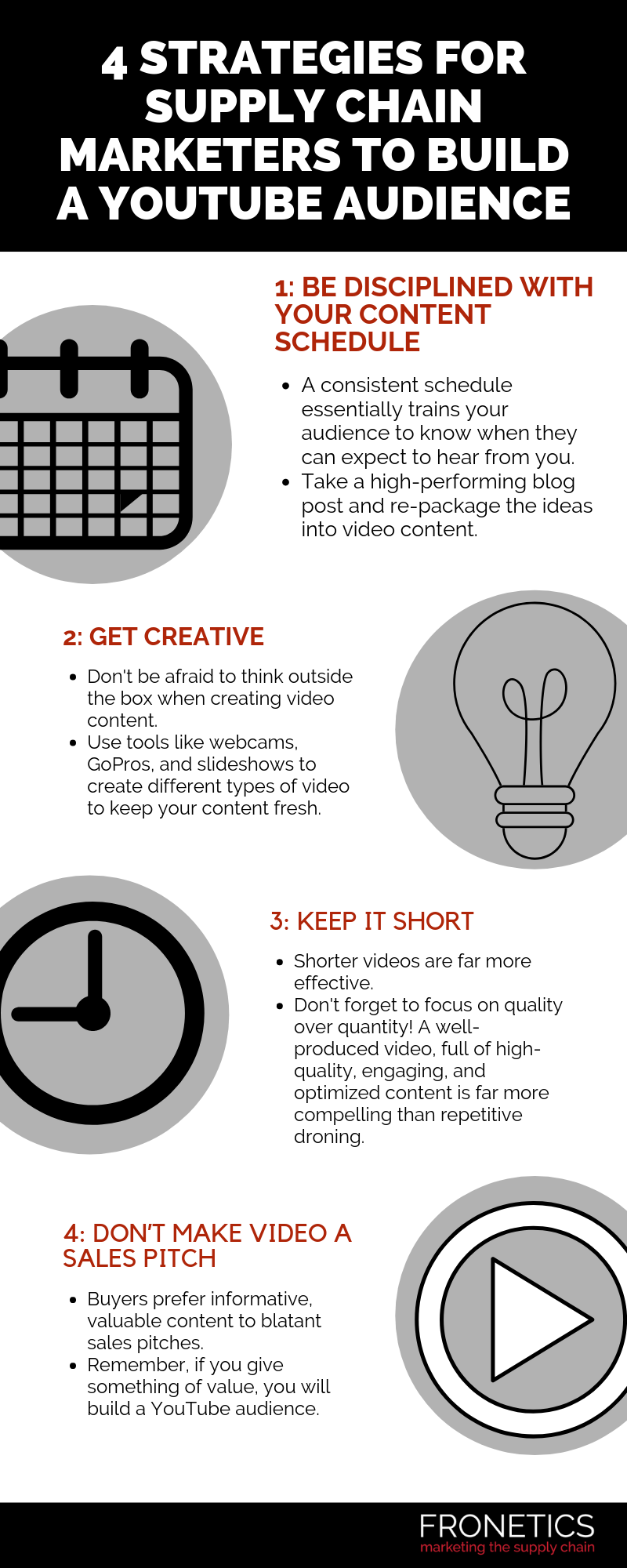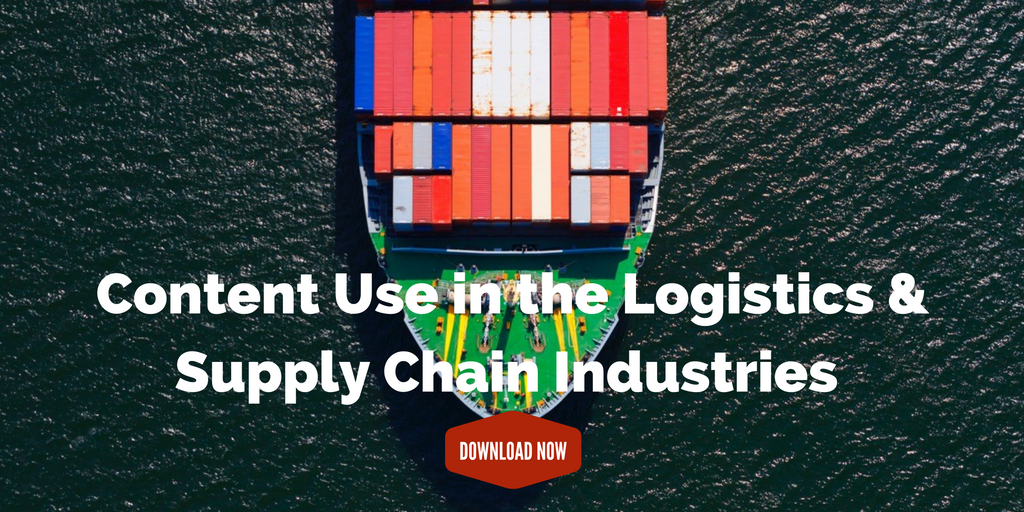
by Fronetics | May 9, 2019 | Blog, Content Marketing, Logistics, Manufacturing & Distribution, Marketing, Supply Chain
Putting your audience’s informational needs first when publishing blog content is the only way to guarantee success in the modern marketing landscape.
Highlights:
- Audiences are increasingly ignoring promotional messaging.
- Buyers are seeking value from vendors outside the sales funnel.
- Information is your best asset — publish what you know.
The latest industry research from the Content Marketing Institute indicates that nearly all (90%) of the most successful B2B content marketers have one thing in common: they prioritize their audience’s informational needs over their sales/promotional message. And that’s compared with only 56% of the least successful B2B content marketers.
Materials-handling marketers should take note when making decisions about publishing blog content. We see companies in this sector making this mistake all the time. They want to fill their blogs with information about their products. But to achieve success in today’s B2B purchasing landscape, you need to be prioritizing your audience’s needs over promotional messaging.
Sales pitches get ignored
A large reason for shifting focus is because audiences are increasingly tuning out sales pitches. This generation of buyers has been heavily marketed to their entire lives, and they don’t hesitate to swipe left at the slightest hint of someone trying to sell them something.
[bctt tweet=”This generation of buyers has been heavily marketed to their entire lives, and they don’t hesitate to swipe left at the slightest hint of someone trying to sell them something. ” username=”Fronetics”]
Think for a moment about your own personal experiences with email, social media, and even phone calls. The truth is, most of us tune out overt sales pitches, either hitting delete or scrolling past them. We’ve moved beyond a time when marketing is about pushing your products.
Your blog, therefore, should not be another channel for selling. But, what kinds of information should you publish?
Provide value by putting customer needs first
The answer is actually quite simple. What information or expertise do your buyers want? Your most valuable commodity is your unique understanding of the challenges your audience faces. If you begin publishing blog content that answers their questions, they’ll be more likely to find you, remember you, and become your customer.
As you think about publishing blog content, take a step back and think about the questions your buyers ask, either of you, on social media, or elsewhere. Examine industry publications to determine the challenges faced by your target buyer persona.
Does your content answer those questions? Does it offer value in and of itself? And does it inform your audience about how you are there to help them? If the answer to these questions is yes, then you’re taking the right steps toward materials-handling marketing with today’s B2B buyers.
Related posts:


by Fronetics | May 8, 2019 | Blog, Content Marketing, Logistics, Manufacturing & Distribution, Marketing, Strategy, Supply Chain
Brand awareness is key in optimizing your content marketing efforts but can be challenging to quantify. Here are four metrics to help you measure brand awareness.
Highlights:
- Use tools, like SharedCount, to track the number of times a piece of your content has been shared across different social media platforms.
- Use the analytics from blog share bars to track the popularity of your posts and help shape content for your editorial calendar.
- Taking the time to measure brand awareness will ultimately help you in optimizing your digital marketing efforts.
Video transcript:
I’m Katie Russell and I’m a marketing strategist here at Fronetics. Today I’m going to talk to you about four ways to measure brand awareness for your packaging company.
Brand awareness is the extent to which customers – both potential and current – are able to recognize your brand. It is key in optimizing your digital marketing efforts, but it can be hard to quantify. Here are four metrics to help you start measuring brand awareness for your packaging company.
1. Social media reach
Social media reach is the total number of people that your content can reach across social media platforms. Use tools like SharedCount to track the number of times a piece of your content has been shared across different social media platforms, like Facebook, Instagram, and even LinkedIn. This can help you figure out what platforms perform best for your content and can also help you shape the kind of content that you’re putting on social media platforms.
2. Brand mentions
How people talk about your packaging company online? If they are, you need to know about it. Try tracking tools like Google Alerts or Hootsuite to make sure that you know every single time someone talks about your packaging brand or any of your products or services.
3. Blog shares
Here are Fronetics, we talk a lot about the importance of having a blog that posts valuable and informative content to your readers. What’s also important is giving your readers the ability to share this content. It’s as easy as adding a share tool to the side of your blog posts. This helps you reach a larger audience and gain views from people that normally wouldn’t see your content. You can also use the analytics from these share bars to track the popularity of your posts and help shape content for your editorial calendar.
4. Search volume
Use tools like Google Adwords or Moz to track searches for your brand, products, even your blog and social media posts. It can help in refining your keywords that you use throughout your content to know specifically what people are searching for when they’re searching for your packaging brand.
Taking the time to measure brand awareness will ultimately help you in optimizing your digital marketing efforts and will also help increase leads. IF you need more information or need help getting started measuring your brand awareness, visit us at fronetics.com.
Related posts:


by Fronetics | Apr 23, 2019 | Blog, Content Marketing, Marketing
As the purchasing landscape increasingly skews younger, you need to think about how to improve your visual content to satisfy buyers’ preferences.
Highlights:
- Audiences increasingly prefer visual content.
- Optimize visual content for search engines by including text.
- Use graphics to make data pop.
Digital natives, who make up the majority of today’s B2B purchasing landscape, are highly steeped in online content. And, it may come as no surprise, they overwhelmingly prefer visual presentation, whether in video, infographic, animation, or gif format. What does this mean? Supply chain marketers need to adapt or be left behind.
[bctt tweet=”Good content marketing is all about presenting information in a story format. Great content marketing also packs emotional resonance. ” username=”Fronetics”]
While this doesn’t mean that text-based marketing is a thing of the past, it does mean that all your branded content — from blog posts to infographics to case studies to video — needs to be design-minded and visually appealing. These five suggestions will help improve your visual content game.
5 ways to improve your visual content
1) Optimize for search engines.
The biggest downside to visual content such as videos and infographics is that they aren’t searchable in the way that text-based content is. But this doesn’t mean that you need to lose out on the SEO benefits when publishing this type of content.
First off, it pays to post a text transcript with video or accompanying explanatory text with infographics and images. It’s also important for you to categorize and organize your visual content, which means labeling visual assets like logos and images with relevant keywords. When publishing them, be sure to tag images with keywords.
2) Make data interesting.
Common sense tells us that reading a bunch of numbers is far less compelling than seeing numerical data presented graphically. B2B marketers are in a prime position to make use of attractive data presentation, such as charts, graphs, animated images, or other formats to display your numerical data.
3) Create reusable graphics.
If you’re investing in visual content creation, it pays to consider how it can be reused. For example, when creating an infographic, consider how you can break it up into multiple graphics, each containing a set of statistics or other information. This way, you can add these smaller graphics to other pieces of text content, boosting engagement and adding visual appeal.
Additionally, keep in mind that visual snippets are ideal for posting on social media, as teasers, or even self-contained Instagram or Facebook Stories.
4) Keep your branding consistent.
A key point with visual content creation is consistent branding. Your brand’s visual presentation includes fonts, colors, font sizes, image styles, and anything else that is a visual indicator of your identity.
The first step to consistent branding is to document visual guidelines clearly and to distribute them to all content creators, along with samples for their use. Each time you publish visual content, make checking against the guidelines part of your editorial process.
5) Use visual content to tell a story.
Good content marketing is all about presenting information in a story format. Great content marketing also packs emotional resonance. When creating visual content, start with the idea of telling a story. Ideally, you’re presenting data in a way that communicates a feeling and elicits an emotional response from the viewer. If your data is impactful, your viewers will forge an emotional connection with your brand.
How are you trying to improve your visual content?
Related posts:


by Fronetics | Apr 9, 2019 | Blog, Content Marketing, Marketing, Social Media, Video Marketing
If you’re trying to build a YouTube audience, you’ll need equal parts strategy, creativity, concision, and valuable subject matter.
Highlights:
- Strategy and creativity are top priorities.
- Keep content short and sweet for maximum impact.
- Offer value to your audience rather than a sales pitch.
An increasing percentage of search traffic is perusing YouTube for information, advice, and education. That makes the platform ideal for getting in front of prospects looking for products and services like yours.
But I’ve seen a lot of B2B marketers getting YouTube wrong. The good news is that the problem is usually that they’re trying too hard — and not in the right ways.
To effectively build a YouTube audience that will eventually become leads and, hopefully, customers, you need to be distributing video content that showcases your organization’s expertise in an approachable way. Here are some simple rules for how to go about that (without barking up the wrong tree).

(Made with Canva)
4 ways to build a YouTube audience
1) Be disciplined about your content schedule.
When it comes to publishing content on social media, when you post is nearly as important as whatyou post. YouTube is no different. Creating and sticking to a consistent schedule for posting new content essentially trains your audience and lets them know when they can expect to hear more from you.
Creating video content consistently doesn’t need to feel like reinventing the wheel. First off, videos should be part of your content calendar in the same way as blog posts, case studies, and other forms of content. You don’t need to create brand new material for each video. Take a high-performing blog post and re-package the ideas into video content.
2) Get creative.
Creativity for B2B companies is all about striking the right balance between entertaining presentation and informative, high-quality content. Think about approaching the information you want to convey in a different way. Can you use a different medium (like animation) or interview two subject-matter experts together if your one-on-one interviews are feeling stale?
There are plenty of technologies available today that will help you create exciting, engaging video content relatively cheaply. Or you could always consider outsourcing your videography.
3) Keep it short.
While we’ve seen recent growth in long-form YouTube content, for most B2B marketing purposes, shorter videos are far more effective. Of course, this is good news in that producing shorter videos can be less time-consuming and costly. But I cannot emphasize enough the importance of quality over quantity here.
[bctt tweet=”A 1- to 2-minute video of high-quality, well-edited content will get far more engagement (and be more successful in helping you build a YouTube audience) than 15 minutes of lecturing or poorly executed, complex animation.” username=”Fronetics”]
A 1- to 2-minute video of high-quality, well-edited content will get far more engagement (and be more successful in helping you build a YouTube audience) than 15 minutes of lecturing or poorly executed, complex animation. If you have a lot of footage about a certain subject, consider releasing a series of shorter videos.
4) Don’t make video a sales pitch.
Content marketing is inbound marketing, and video is no different. Countless studies have shown that increasingly buyers prefer informative, valuable content to blatant sales pitches.
This doesn’t mean that your content shouldn’t be branded, but it does mean that your focus in creation and execution needs to be what you can offer your audience, rather than you’re asking from them.
Use your video content to address specific concerns or answer questions that are relevant to your target audience. It’s simple: if you give something of value, you will build a YouTube audience that could eventually become your leads and customers.
What have you been doing to build a YouTube audience?
Related posts:


by Fronetics | Apr 3, 2019 | Blog, Content Marketing, Manufacturing & Distribution, Marketing, Supply Chain
Here’s why manufacturing marketers should skip the sales pitch and create content that prioritizes the needs of their target audience.
Highlights:
- Research indicates that only about half of manufacturing marketers are prioritizing their audience’s needs when creating content.
- Inbound marketing (like content marketing) is more effective than outbound marketing for B2B businesses.
- A documented strategy will help you get started creating focused, quality content.
One statistic is sticking out to me in the Content Marketing Institute’s Manufacturing Content Marketing 2019: Benchmarks, Budgets, and Trends report. According to the research, half (51%) of manufacturing marketers reported that they always or frequently prioritize their sales/promotional message over their audience’s informational needs when creating content for content marketing purposes.
Let’s think about that for a second.
A preponderance of manufacturing content marketers are, unfortunately, missing the point.
We’ve written before about why inbound marketing, like content marketing, is more effective for the supply chain than more traditional outbound marketing techniques. And while it’s true that “the supply chain is increasingly seeing the value of moving to an inbound marketing strategy,” the CMI’s research suggests that it’s taking some marketers a long time.
Why you should be putting your audience’s informational needs first
Why should you be emphasizing your audience’s informational needs over your promotional goals when creating content?
[bctt tweet=”One of the basic premises of content marketing is the recognition that, increasingly, your customers want much more from you than your product.” username=”Fronetics”]
The short answer is: because your audience prefers it. One of the basic premises of content marketing is the recognition that, increasingly, your customers want much more from you than your product. For manufacturing marketers, this means that customers want value separate from and outside of the sales funnel.
Enter content marketing. Creating effective marketing content relies on accepting that your business has much more to offer than its primary products and services. In fact, your most valuable commodity, as we’ve often said before, isn’t any material or service — it’s the knowledge, expertise, and informed, unique perspectives you have to offer.
Strategize to put customers first
To successfully adjust your content marketing efforts to put your customers’ informational needs first, the first step is having a well-defined, measurable strategy — and documenting it. This means defining precisely who you’re trying to reach and developing a complete target buyer persona(s).
Once you’ve defined exactly who you’re trying to reach, it’s time to identify the unique questions, needs, and challenges this target buyer faces. Chances are, your business has not only the products to meet those needs, but also the information to answer question and offer valuable insights.
One of the benefits of a documented strategy, with clearly stated objectives, is that it allows you to set up metrics and evaluate your successes and shortfalls. This is where you can start listening to your target buyers. You can even solicit responses from them via email and social media that will allow you to target and hone your efforts in the future.
Meeting manufacturing marketers’ challenges
The CMI’s research reinforces the fact that manufacturing marketers face unique challenges. The top reported challenge was “creating content that appeals to multi-level roles within the target audience.”
According to Achinta Mitra, founder of Tiecas, an industrial marketing consultancy, “Buying decisions are made by a committee and very rarely, if ever, by an individual. Some of these stakeholders may never interact with your content or visit your site.”
Essentially, there are various types of buyers with various needs — meaning their content needs are different. Mitra advises bringing “subject matter experts to the forefront, and letting marketing do the heavy lifting in the background.” He bases his advice on the belief that “one engineer to another is a powerful concept for earning trust, gaining credibility, and winning the mindshare of engineers and industrial professionals.”
If you’re thinking beyond downloads when creating content, and truly prioritizing quality information, your content will function broadly throughout the complex manufacturing buyer’s journey.
Related posts:







